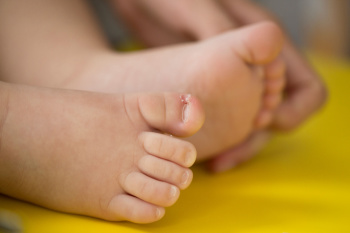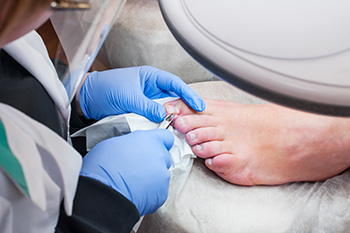
An ingrown toenail occurs when the edge of the nail grows into the surrounding skin, causing irritation and discomfort. In children, this can be caused by improper nail trimming, wearing tight shoes, injuries, or inherited nail shapes. Symptoms include redness, swelling, pain along the nail edge, and sometimes drainage if an infection develops. Children may avoid walking or show signs of discomfort during activity. A podiatrist can gently lift or remove the ingrown portion, treat any infection, and provide guidance to prevent recurrence. Early care is important to avoid worsening symptoms. If your child is showing signs of an ingrown toenail, it is suggested that you schedule an appointment with a podiatrist to ensure safe, effective treatment and lasting relief.
Making sure that your children maintain good foot health is very important as they grow. If you have any questions, contact one of our podiatrists of Highlands Foot and Ankle. Our doctor can provide the care you need to keep you pain-free and on your feet.
Keeping Children's Feet Healthy
Having healthy feet during childhood can help prevent medical problems later in life, namely in the back and legs. As children grow, their feet require different types of care. Here are some things to consider...
Although babies do not walk yet, it is still very important to take care of their feet.
Avoid putting tight shoes or socks on his or her feet.
Allow the baby to stretch and kick his or her feet to feel comfortable.
As a toddler, kids are now on the move and begin to develop differently. At this age, toddlers are getting a feel for walking, so don’t be alarmed if your toddler is unsteady or ‘walks funny’.
As your child gets older, it is important to teach them how to take care of their feet.
Show them proper hygiene to prevent infections such as fungus.
Be watchful for any pain or injury.
Have all injuries checked by a doctor as soon as possible.
Comfortable, protective shoes should always be worn, especially at play.
If you have any questions please feel free to contact our office located in Waco, TX . We offer the newest diagnostic and treatment technologies for all your foot and ankle needs.

Ingrown toenails occur when the edge of the nail grows into the skin beside it, often affecting the big toe. This can cause swelling, pain, and redness. As an ingrown toenail worsens, the area may become infected, sometimes producing pus and increased tenderness. Common causes of ingrown toenails include trimming the nails too short or with rounded edges, wearing tight shoes, and repeated toe injuries. Wearing high heels or shoes with a narrow toe box may increase pressure on the nail, adding to the risk of it growing into the skin. People who sweat heavily or have fungal nail infections may also be more prone to developing an ingrown toenail. If the toenail becomes infected or the pain becomes severe, surgery may be needed to remove part of the nail. A podiatrist can provide care that may include nail removal and other treatments to prevent the regrowth of the problem area. If you have symptoms of an ingrown toenail, it is suggested that you schedule an appointment with a podiatrist for appropriate treatment.
Ingrown toenails can become painful if they are not treated properly. For more information about ingrown toenails, contact one of our podiatrists of Highlands Foot and Ankle. Our doctor can provide the care you need to keep you pain-free and on your feet.
Ingrown Toenails
Ingrown toenails occur when a toenail grows sideways into the bed of the nail, causing pain, swelling, and possibly infection.
Causes
- Bacterial infections
- Improper nail cutting such as cutting it too short or not straight across
- Trauma to the toe, such as stubbing, which causes the nail to grow back irregularly
- Ill-fitting shoes that bunch the toes too close together
- Genetic predisposition
Prevention
Because ingrown toenails are not something found outside of shoe-wearing cultures, going barefoot as often as possible will decrease the likeliness of developing ingrown toenails. Wearing proper fitting shoes and using proper cutting techniques will also help decrease your risk of developing ingrown toenails.
Treatment
Ingrown toenails are a very treatable foot condition. In minor cases, soaking the affected area in salt or antibacterial soaps will not only help with the ingrown nail itself, but also help prevent any infections from occurring. In more severe cases, surgery is an option. In either case, speaking to your podiatrist about this condition will help you get a better understanding of specific treatment options that are right for you.
If you have any questions please feel free to contact our office located in Waco, TX . We offer the newest diagnostic and treatment technologies for all your foot and ankle needs.

Custom orthotics can be used to relieve foot pain and discomfort. They're also used to treat various foot conditions and deformities. Flat feet, bunions, and Morton's neuroma are just a few of the foot conditions that have been known to benefit from the use of orthotics.
Comfy feet are happy feet! Contact us today.

Athlete's foot is a common skin condition that often starts between the toes and may cause itching, burning, or dry, cracked skin. It is caused by a fungus that thrives in warm, moist areas like locker rooms, damp socks, or shared showers. Early treatment can prevent the infection from spreading to other areas of the foot or even to other people. Mild creams, powders, or sprays may be effective when used consistently. Keeping feet clean and dry, wearing breathable shoes, and changing socks regularly can also help clear up the problem. In more stubborn cases, prescription-strength medication may be needed. If the infection is not improving or seems to be getting worse, it is suggested that you visit a podiatrist for effective relief tips.
Athlete’s Foot
Athlete’s foot is often an uncomfortable condition to experience. Thankfully, podiatrists specialize in treating athlete’s foot and offer the best treatment options. If you have any questions about athlete’s foot, consult with one of our podiatrists from Highlands Foot and Ankle. Our doctor will assess your condition and provide you with quality treatment.
What Is Athlete’s Foot?
Tinea pedis, more commonly known as athlete’s foot, is a non-serious and common fungal infection of the foot. Athlete’s foot is contagious and can be contracted by touching someone who has it or infected surfaces. The most common places contaminated by it are public showers, locker rooms, and swimming pools. Once contracted, it grows on feet that are left inside moist, dark, and warm shoes and socks.
Prevention
The most effective ways to prevent athlete’s foot include:
- Thoroughly washing and drying feet
- Avoid going barefoot in locker rooms and public showers
- Using shower shoes in public showers
- Wearing socks that allow the feet to breathe
- Changing socks and shoes frequently if you sweat a lot
Symptoms
Athlete’s foot initially occurs as a rash between the toes. However, if left undiagnosed, it can spread to the sides and bottom of the feet, toenails, and if touched by hand, the hands themselves. Symptoms include:
- Redness
- Burning
- Itching
- Scaly and peeling skin
Diagnosis and Treatment
Diagnosis is quick and easy. Skin samples will be taken and either viewed under a microscope or sent to a lab for testing. Sometimes, a podiatrist can diagnose it based on simply looking at it. Once confirmed, treatment options include oral and topical antifungal medications.
If you have any questions, please feel free to contact our office located in Waco, TX . We offer the newest diagnostic and treatment technologies for all your foot care needs.
